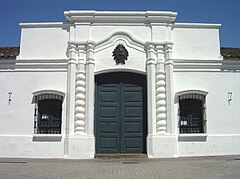House of Tucumán
| Casa de Tucumán | |
|---|---|
| Casa histórica de la independencia | |

Casa de Tucumán, site of the Argentine declaration of independence
|
|
| General information | |
| Town or city | San Miguel de Tucumán |
| Country | Argentina |
The Casa de Tucumán (meaning "House of Tucumán" in Spanish, officially Casa Histórica de la Independencia) is a historic building and museum located in San Miguel de Tucumán, Argentina, built during the colonial times. The Congress of Tucumán worked in this house during the Argentine War of Independence, and issued the Argentine Declaration of Independence on July 9, 1816. It was nationalized decades later, and partially demolished for its poor condition. It was declared a National Historic Monument of Argentina in 1941, and reconstructed, with simplified details, (illustration below) in its original layout.
The city of San Miguel de Tucumán was first founded in Ibatín in 1565. For strategic reasons, it was left and founded again in its current location in 1685. In the Spanish Colonial architecture there was a main plaza surrounded by the most important buildings, and the city was organized in a grid of squares. Each square was divided in four parts, and each one was given to a vecino. The layout of the city founded in 1685 was the same than in the old city. The location of the Casa de Tucumán was owned by Diego Bazán y Figueroa. The actual house was built in 1760 by Francisca Bazán and Miguel Laguna.
The Argentine War of Independence began in 1810, and the battle of Tucumán was fought in September 24, 1812, outside the city. The Laguna-Bazán family was not living in the house at the time, which was used as a barracks for the troops of the Army of the North. The government established the customs and the Regimental depot in 1815, paying a fee to the owners of the house for it. The Congress of Tucumán, with representatives of most provinces of the United Provinces of the Río de la Plata, began to work in 1816. Family tradition maintained that the Laguna Bazán donated the house to the state for the Congress and that other families and religious orders donated furniture for it, but historian Ramón Leoni Pinto proved in 1974 that the house was rented to the state and that the furniture was built by slaves for the event. The Congress began to work on March 1, 1816, and issued the Argentine Declaration of Independence on July 9. The Congress continued its work up to February 1817, when it was moved to Buenos Aires.
...
Wikipedia
